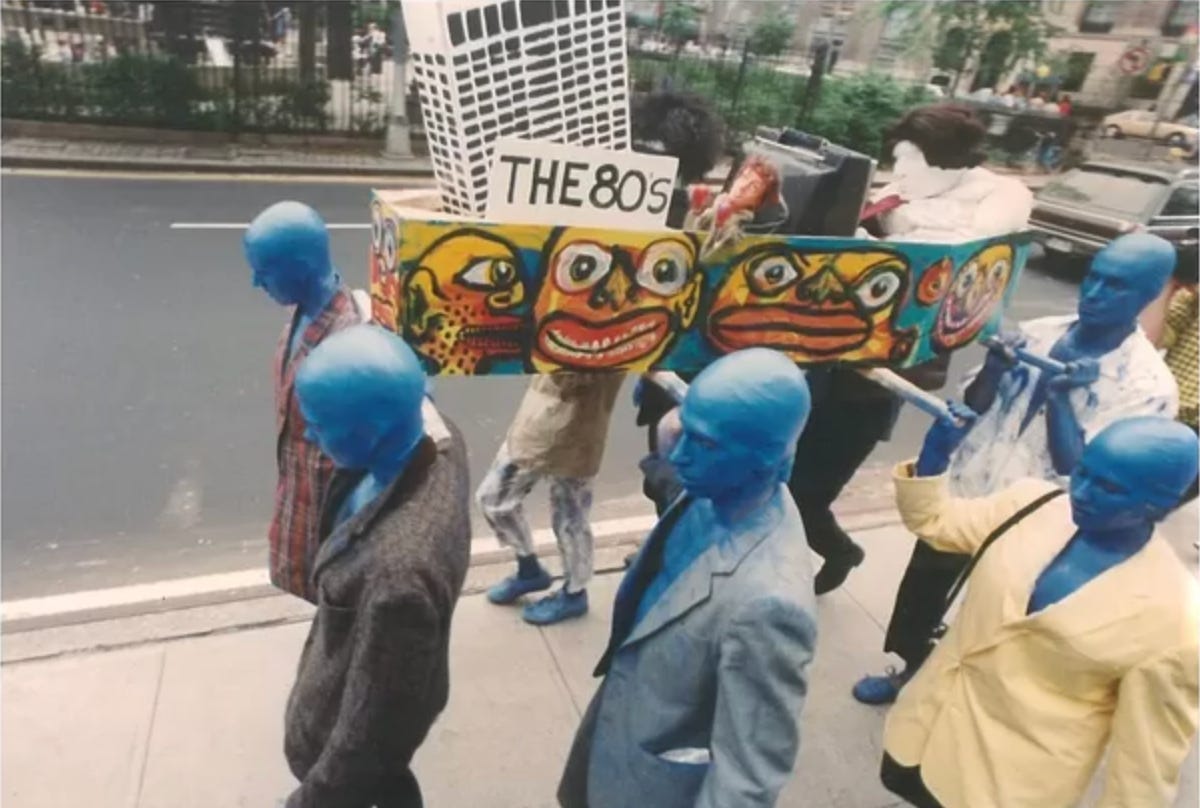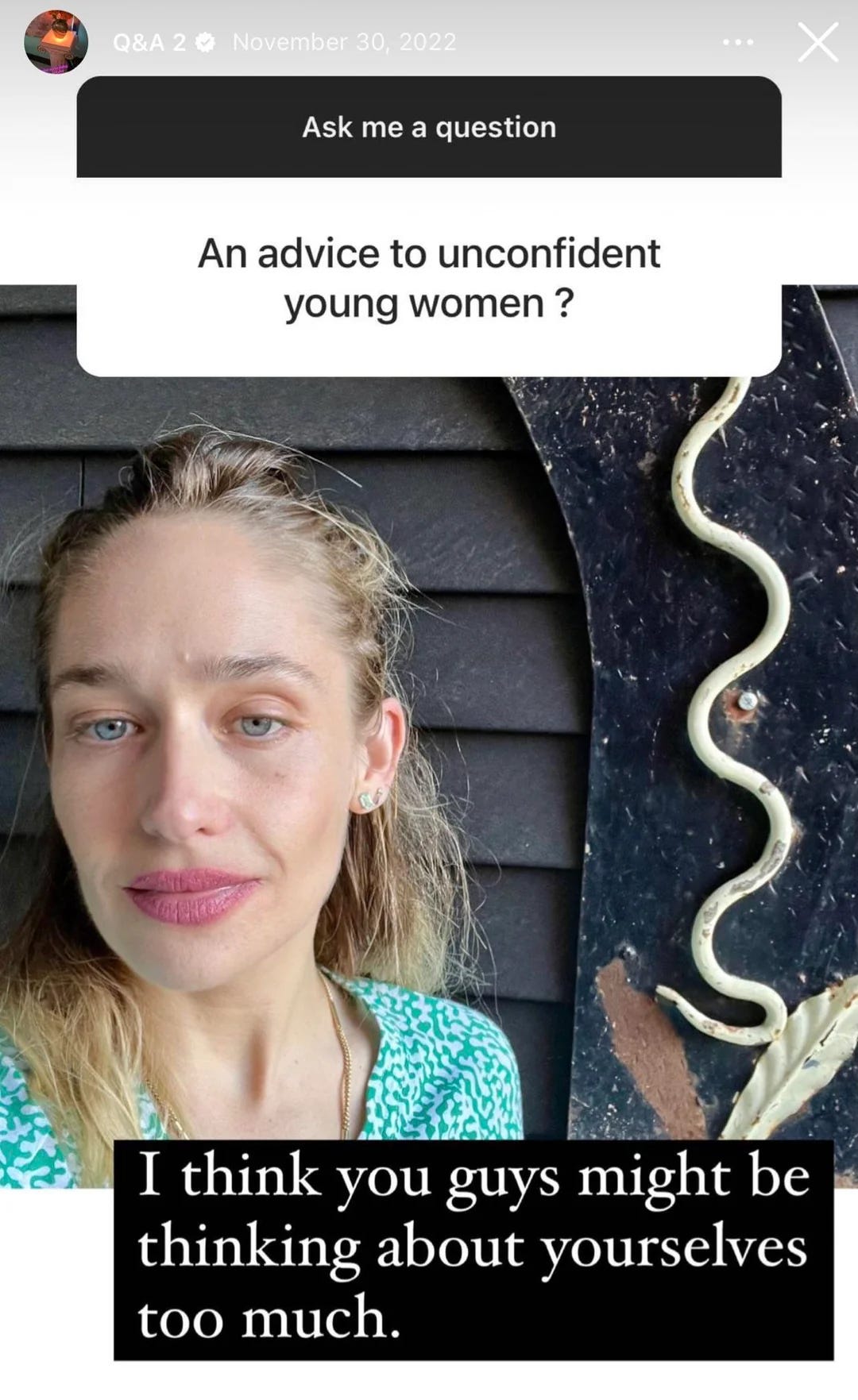Maybe the Real Substack Essay is the Friends We Made Along the Way
on Trisha Paytas and the Blue Man Group
After two months of trying to write an essay about the Blue Man Group, it’s time to pull the plug.
When I began this Substack, it was “for fun”. It only took a handful of subscribing strangers for my sense of fun to be swallowed by a beautiful monster who found glee in dangling Arbitrary Quality on a stick held out in front of me.
There is no person or entity making me write about the Blue Man Group except myself, and I just can’t do it anymore. My Editor has stopped editing my drafts. The blue freaks have derailed my entire life. In memoriam, here are the highlights:
For a long time, the essay was called The Slow Death of Weird Art, and it was about the two funeral processions bookending the Blue Man Group’s prime years (the Central Park performance art stunt that started it all, and the protest in Chicago at the abrupt end of their 30-year run).
The next iteration of the essay was called The Life Cycle of Weird Art, and it was the same, mostly, but I tried to conclude it with a message of “everyone go make weird art for the sake of weird art!” because I didn’t know what else to say.
The truth is, I don’t care about the Blue Man Group. They’re bald and they’re blue and they’ve been great at the Chubby Bunny Challenge for thirty years. The show has survived long enough to be referenced on The Simpsons and to live out its final, private-equity-owned years in Boston, Las Vegas, and Orlando. Ah, culture!
The Blue Man Group made a weird thing that culminates in no thought-provoking point, and maybe you love it because it’s strange and entertaining and maybe you hate it because you’re cynical like me. Either way, the show is a vibrant, boring example of “experimental” art, started by some anti-yuppie New Yorkers and made successful by the children of yuppies.
Working on my Blue Man Group drafts was always just an excuse to rewatch this video, anyways:
YOU DON’T NEED TO WRITE ABOUT THINGS JUST FOR THE HELL OF IT. The internet does not need more useless media summaries and half-baked arguments about nothing. Sometimes the Substack essay is realizing that not everything needs to be a Substack essay.
—
The other music-theater-fusion production I recently attended was the Trisha Paytas Eras Tour. I thought I’d have a lot to say about it, and then Trisha never mentioned Frenemies. Not once.
For a show that was deeply invested in the history of Paytas’s career—deliberately structured around her eras—I thought the erasure of Frenemies was historical revisionism at best and disrespectful to the fanbase at worst. Maybe there’s some legal thing where she can’t use any content owned by Klein, but I never would have been at Radio City Music Hall1 that night had it not been for the joy of watching Frenemies during the joyless time of quarantine. #tragic
But it was a good show. Weird. It seemed like no one knew what they were doing there, including Trisha Paytas.
She came on after 8 for a 7:30 start time, splitting the difference between Broadway-five-to-ten-minutes late and concert-without-an-opener late. She was just backstage posting things on her Instagram story while we all waited for her to come on, which I know because Will kept showing Meredith and me what she was posting on her Instagram story while we were waiting for her to come on.
She sang some songs and spoke to a few audience members. She borrowed a sparkly pink cowboy hat and performed “Shallow” a cappella, thank God. She took a moment to apologize for her problematic past and told us about the time she checked herself into a mental hospital—all the classics.
It’s interesting to think that Paytas became famous (in part) for her internet breakdowns and various controversies, and then her fame enabled her to go on tour—vaguely for music but mostly just for being famous.
So when people come to see her… what is it they want to see? What does she feel obligated to display? How does an unfiltered, sensationalist force succeed in an organized show? How does someone like Trisha Paytas contain the liquidness of her own virality for a quasi-concert with thousands of live viewers?
If you had asked me beforehand “what are you paying to see,” I probably would’ve said something along the lines of just Trisha being Trish, because she’s one of the most iconic examples of internet celebrity in the world today. But there are layers to her celebrity status, and it does get complicated, especially for someone like Paytas, whose fame is a messy bundle of totally distinct viral moments, disconnected across years and brought together by her singular cult of personality.
When My Editor asked me who Paytas was, I tried to describe a dirty kitchen floor, a pandemic podcast, a love for Jesus, a lip-synced “King Tut” cosplay, OnlyFans, and buttered noodles all at once. Internet personality, I finally said. She’s an internet personality.
I think her eclectic content combined with her singleminded pursuit of stardom is precisely why I find Paytas so interesting, but it does make for a confusing stage adaptation. Meredith put it best when she said that the show made her think a lot about who we make famous and why.
Regardless, I’m not writing a whole Substack essay about it. That Jemima Kirke screenshot is having a resurgence right now, and I think I just need to go enjoy the beautiful weather.
If you’re looking for a music recommendation, stream “Bubbly” from Trisha Paytas’s new EP, Postpartum Popstar. It’s an earworm, and it’s terrible, and what else are you going to do? Anguish over a garbage essay about the Blue Man Group? Think about yourself too much?
Until next time! MWAH!
My Editor wanted to double-check that Radio City Music Hall was well-known enough to name it without further context, and I said “It’s where The Rockettes perform!” and My Editor, deadpan, immediately replied with “I don’t care about legs”.










Poor alternative music fans ☹️
I would read your blue man group essays! You should sell an extended cut